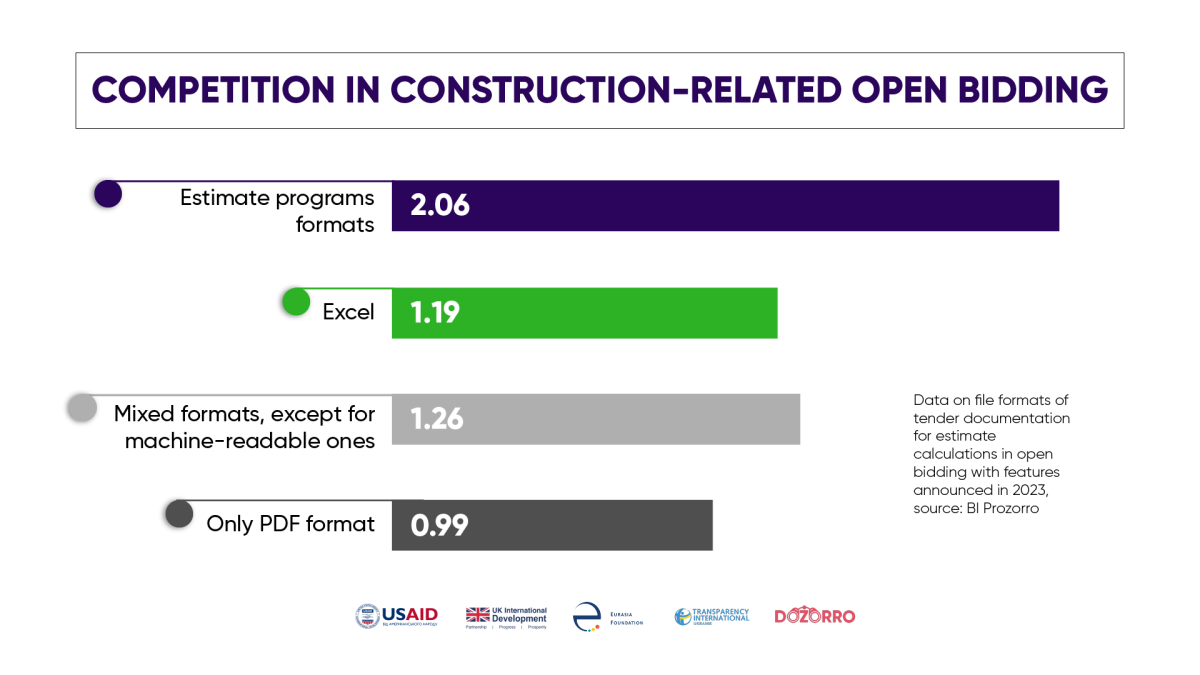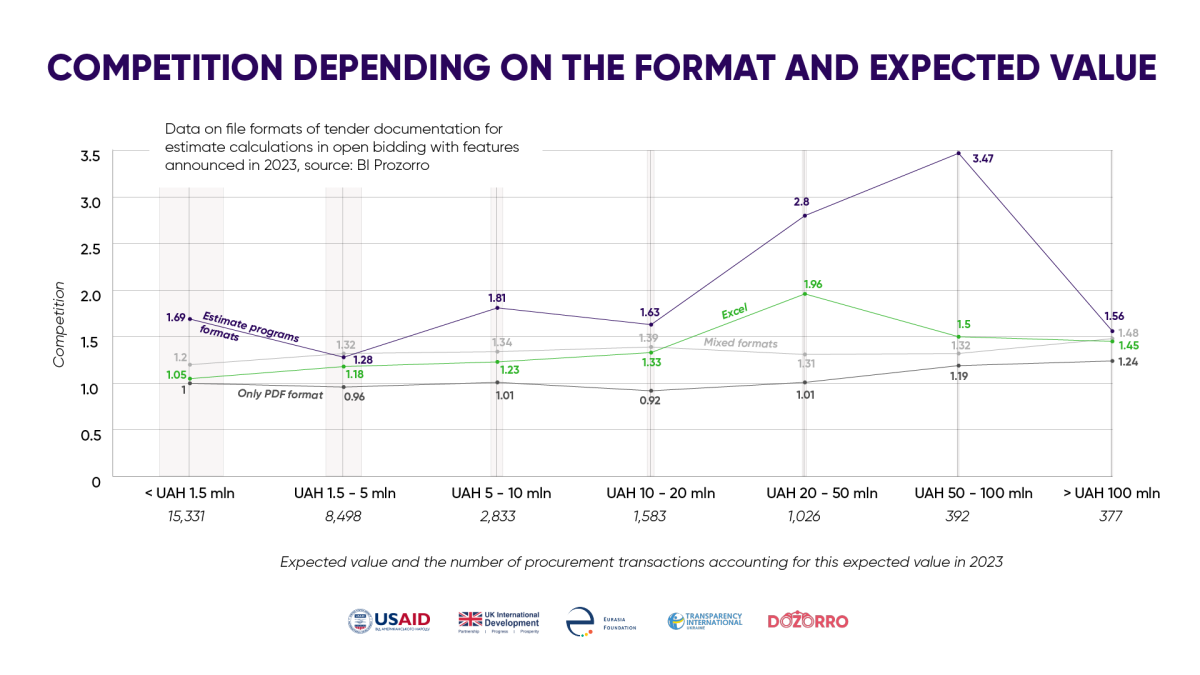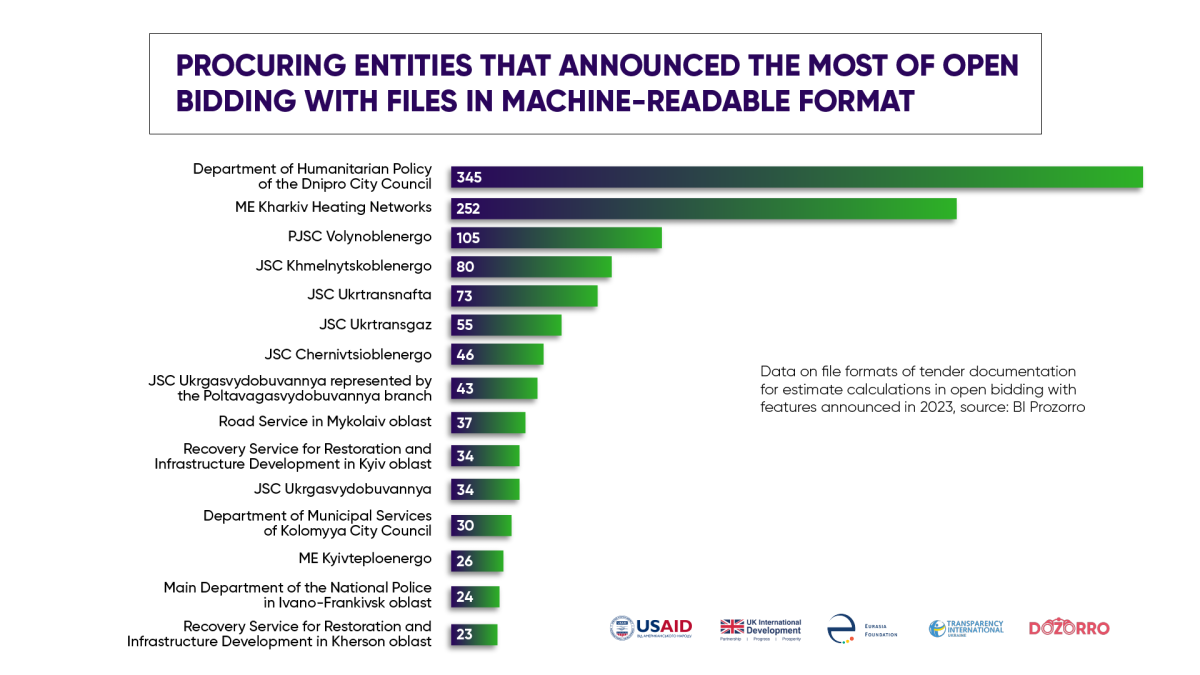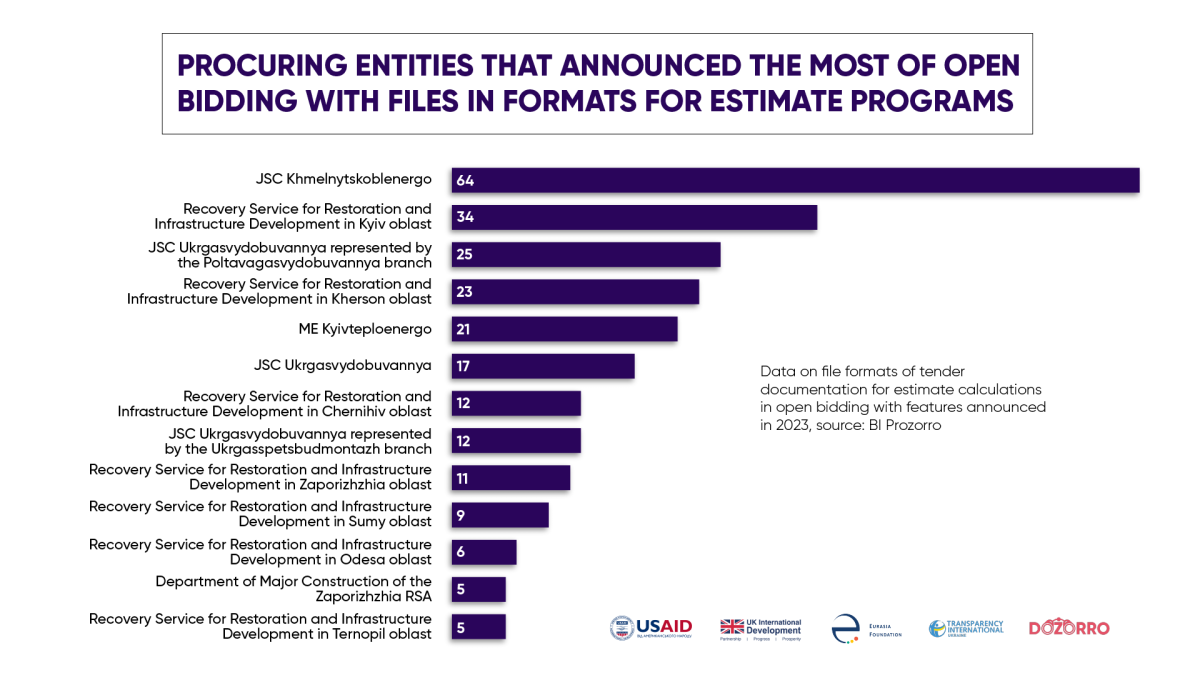

In early February, we analyzed how the deadline for submitting proposals in construction tenders impacted savings. In 2023, 75% of construction tenders had a minimum deadline of 7 days. As expected, more participants took part in those procurement transactions, which provided for more time to prepare proposals. In the case of construction, a week is mostly not enough to collect standard documents, make all the necessary calculations, and form a full estimate. Following our analysis, this problem was solved: the government increased the minimum period for submitting proposals for the procurement of works to 14 days.
At the same time, the deadline for submission is not the only factor that determines whether the business will participate in a procurement transaction. Among other things, its decision will be influenced by the quality of the tender documentation itself, in particular its conditions and the format in which it is published. It implies whether the necessary documents and forms for calculations will be in machine-readable format or whether the procuring entity will download them in PDF format, which needs to be manually reprinted to get started.
Therefore, we decided to study how often procuring entities published the files necessary for estimates in machine-readable format within the tender documentation last year.
In general, machine-readable data are those that a computer can recognize and process automatically. For example, it can independently calculate the total amount of the figures from an Excel sheet but not from a photo of the same sheet. There are many machine-readable formats, but within the framework of this study, we considered the following:
- Excel files;
- files in the data exchange formats of estimate programs imd, .ims, .imp, .idc, .ipd, .ibs, .bds, .bdd, .bdp, .bsdu, .bdcu, .bpdu, .bsdr, .bdcr, .bpdr.
They are used to draw up estimates that businesses usually need to submit as part of their tender proposal.
For the analysis, we considered procurement transactions with a known number of participants using the following CPV codes:
- 45400000-1 Final construction works
- 45200000-9 Works related to objects of completed or unfinished construction and objects of civil construction
- 45300000-0 Construction and installation works
- 45100000-8 Site preparation
In 2023, procuring entities announced 34,213 competitive lots, with the procurement item being construction works. It was open bidding for the most part, and simplified procurement accounted for 12.2%.
Documents in machine-readable format were found in 2,301 transactions, that is, in 6.73%. Another 86.45% of the lots had files in other formats, for example, DOCX + PDF, in the tender documentation. However, according to aggregated data, it is unknown which format will be used to publish the assignment required for estimate calculations. In the remaining 6.82% of procurement transactions, all files were exclusively in PDF format.
Open bidding
Last year, there were 1,956 open tenders for construction, where procuring entities added documents in machine-readable formats. Almost 86% of them (1,679) were procurement transactions with Excel files. Only 14% of lots (277) had files for special budget programs: either solely those files or these files + Excel.
Mixed formats, other than machine-readable ones, were found in 25,981 procurement transactions. In another 2,103 lots, the documents were only provided in PDF format.
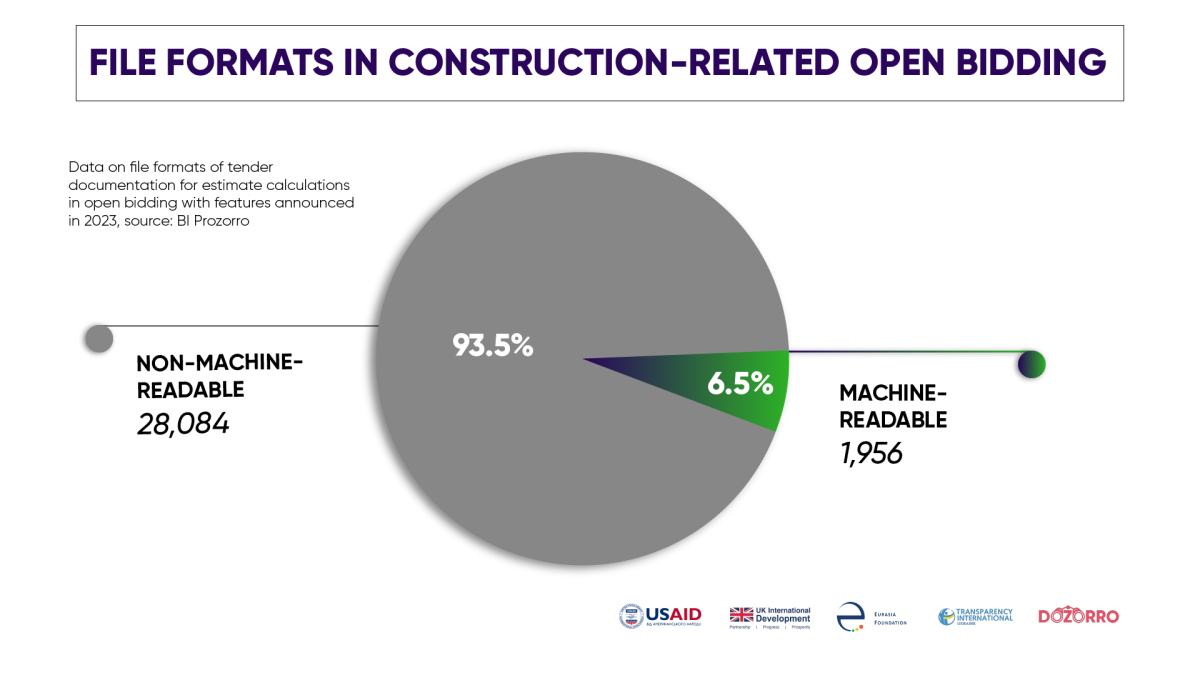
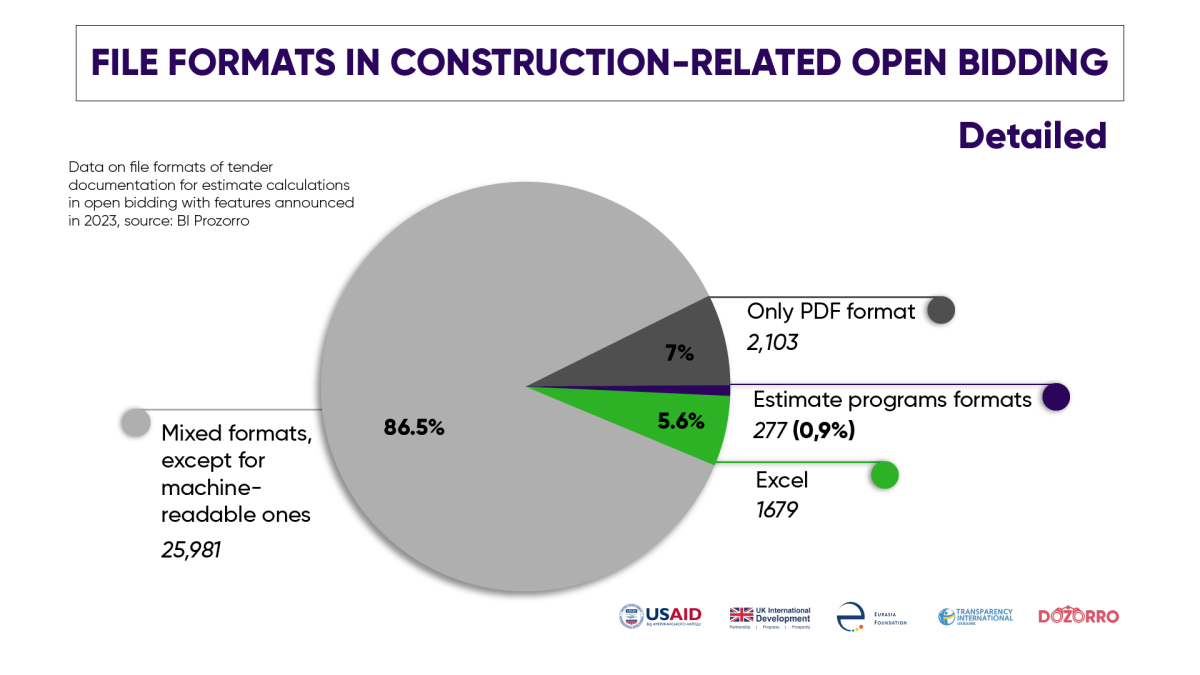
Competition in bidding
The further the documents of a procurement transaction’s tender documentation were from PDF format and closer to machine-readable data, the higher the competition. Thus, in lots where all files were in PDF format, proposals were submitted by an average of 0.99 participants. In procurement with a mixed file format, there were already 1.26 of them. In the case of machine-readable documents, there were 1.3 participants. If we take a closer look at the bidding with documents in machine-readable formats and divide them into subcategories, then:
- lots with Excel files have a similar competition indicator with lots that have files of mixed formats—1.2 proposals;
- in procurement transactions where the documents necessary for calculations were published in formats for special budget programs, the competition indicator was significantly higher—2.1.
Procuring entities that added files in machine-readable formats to the tender documentation, although not much more, still set longer deadlines for submitting proposals—an average of 9.44 days against 8.47 in general. In the lots with documents in the formats of budget programs, the average term reached 13.82 days.
We also analyzed competition in bidding with different expected values. In particular, we used the cost of procurement as a sign to divide the order on Prozorro by the complexity of the objects—the more expensive, the more difficult. Of course, this is not a perfect approach, but we could not find a better option.
In 88% of the open bidding that was included in our sample, the expected value did not exceed UAH 10 million. Therefore, we have considered this range in more detail, dividing it into three groups:
- up to UAH 1.5 million.We considered what exactly was purchased for such amounts; for the most part, within such a range, the procurement item is simple construction work (insulation of the building facade, replacement of windows, installation of new sanitary ware, laying of paving tiles, etc.).
- from UAH1 million to UAH 5 million. Construction works of more complex configurations: roofing works, repairs of minor objects.
- UAH 5–10 million.Construction objects of this group are characterized by increased complexity, and the performance of works requires engaging certain special construction equipment (cranes, bulldozers, loaders, etc.) and qualified engineers.
The following ranges of expected value are grouped under similar assumptions that the increase in complexity occurs in parallel with the increase in expected value (EV) and the volume of works performed.
So, we chose the following groups:
- EV< UAH 1.5 million;
- 1,5 <= EV < UAH 5 million;
- 5 <= EV < UAH 10 million;
- 10 <= EV < UAH 20 million;
- 20 <= EV < UAH 50 million;
- 50 <= EV < UAH 100 million;
- EV > UAH 100 million
| EV group | EV range in the group | Number of lots | % of lots | Estimate files | Excel | Mixed formats | |
| 1 | EV< UAH 1.5 million; | 15,331 | 51.04 | 1.69 | 1.05 | 1.00 | 1.20 |
| 2 | 1,5 <= EV < UAH 5 million; | 8,498 | 28.29 | 1.28 | 1.18 | 0.96 | 1.32 |
| 3 | 5 <= EV < UAH 10 million; | 2,833 | 9.43 | 1.81 | 1.23 | 1.01 | 1.34 |
| 4 | 10 <= EV < UAH 20 million; | 1,583 | 5.27 | 1.63 | 1.33 | 0.92 | 1.39 |
| 5 | 20 <= EV < UAH 50 million; | 1,026 | 3.42 | 2.80 | 1.96 | 1.01 | 1.31 |
| 6 | 50 <= EV < UAH 100 million; | 392 | 1.30 | 3.47 | 1.50 | 1.19 | 1.32 |
| 7 | EV > UAH 100 million | 377 | 1.25 | 1.56 | 1.45 | 1.24 | 1.48 |
It turned out that for lots in which the documentation was published in PDF format, the average number of participants did not actually change at different expected procurement values. Only for orders worth more than UAH 50 million has the competition slightly increased from 1 to 1.2.
In lots where the terms of reference of the documentation were in the formats of data exchange between estimate programs or in Excel format, we observed an increase in competition depending on the expected value. If 1.6 participants on average took part in lots with an expected value of up to UAH 20 million, then for lots with an expected value of UAH 20 to 50 million, the average level of competition increased to 2.8 participants. The maximum number of participants took part in procurement with an expected cost of UAH 50 to 100 million and amounted to 3.5. This is three times more than with lots that contained documentation only in PDF format.
In general, the highest competition indicator was in lots with machine-readable files for calculations, with a value ranging from UAH 20 to 100 million.
Top procuring entities
Open bidding with machine-readable files for estimates in the tender documentation in 2023 was announced by 240 procuring entities. Most of these lots were published by:
- Department of Humanitarian Policy of the Dnipro City Council—345;
- ME Kharkiv Heating Networks—252;
- PJSC Volynoblenergo—105.
For the most part, they uploaded Excel files.
But only 23 procuring entities used documents in the format for estimate programs in the tender documentation. Among them are Recovery Services, JSC Ukrgasvydobuvannya and its branches, energy infrastructure enterprises, and major construction units of city councils.
In particular, in August 2023, the State Agency for Restoration and Infrastructure Development of Ukraine presented methodological recommendations on public procurement for the regional Recovery Services subordinate to it. The Agency for Restoration advises them to provide, as part of the tender documentation for the procurement of construction works, the approved project planning documentation in full, including estimates in the format of Excel and specialized systems, in particular .ibs, .idc (IBD-6.x), .bsdu, .bdcu (IBD-5.x). The Agency also recommended setting a deadline for submitting proposals of at least 14 days and for procurement transactions with an expected value of UAH 100 million or more—at least 20 days.
Perhaps other procuring entities have similar internal policies.
Simplified procurement
Although the main method of procurement at the moment is open bidding with features, we decided to analyze similar indicators for simplified procurement due to the significant frequency of application (12.2% of construction lots). Machine-readable formats are also rarely used in them—in 8.3% of cases.
In simplified procurement, the impact of the tender documentation format on competition is not visible. For all options, the average number of proposals per lot is 0.93–0.99. At the same time, the deadline for proposal submission in such procurement transactions is shorter, with an average of 3.5 days. The data sample is also small, so this issue needs further study.
Conclusions
Machine-readable formats that allow optimizing the preparation of estimates are a rarity in tender documentation for the procurement of construction works on Prozorro. Thus, in 2023, Excel files or the formats of special budget programs were found only in 6.7% of lots.
But when they are used, competition increases. For example, proposals were submitted by an average of 0.99 participants in open bidding, where all documents in the tender documentation were in PDF format. Instead, lots with files in the formats of budget programs had the average level of competition at 2.1 participants.
The highest competition was observed in lots with files in machine-readable formats with an expected value of UAH 50 million to UAH 100 million—3.47 proposals.
At the same time, procuring entities that used machine-readable document formats were more likely to give the business more time to prepare their proposal—an average of 9.44 days against a total of 8.47 days. In lots with files for budget programs, this figure reached 13.82 days. Presumably, these two factors have a comprehensive impact—the business has a convenient format of documents necessary to prepare a proposal and more time for this.
The government has already increased the minimum deadline for submitting proposals for construction tenders after our previous study. We recommend introducing mandatory disclosure of information required for estimate calculation in machine-readable formats at construction-related open bidding. Namely, in Excel formats and estimate programs. This can be done in several ways. For example, introduce a corresponding obligation into Resolution No.1178 and the law. Or approve the standard tender documentation, which includes the necessary documents in machine-readable formats.
This will allow for:
- preparing estimates of a higher quality and doing it faster;
- preventing abuse when the procuring entity provides documents in machine-readable format only for a favored contractor.
It is also necessary to conduct additional consultations with the business and consider its opinion when developing the provision.
This research is made possible by the generous support of the American people through the United States Agency for International Development (USAID). The contents are the responsibility of Transparency International Ukraine and do not necessarily reflect the views of USAID or the United States Government. This research has been funded by UK International Development from the UK government; however, the views expressed do not necessarily reflect the UK government’s official policies.




